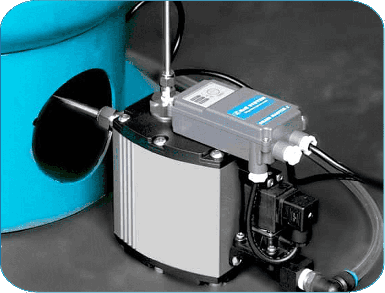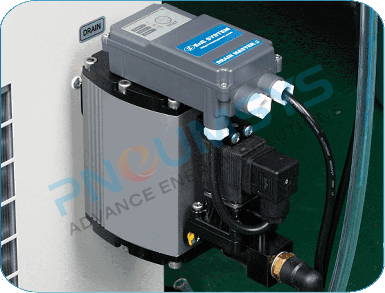Zero Air Loss Level sensing
Auto Drain Valve
Zero Air Loss Level sensing Auto Drain Valve
We offer Drainage Management System that is a complete solution to drainage concerns of many industries, such as chemical and oil refinery factories. It is the management system where conventional drainage system is intercepted by a water control structure, which effectively function as an in-line dam, allowing the drainage outlet to be artificially set at levels ranging from the soil surface to the bottom of the drains. We offer two major systems where in first, water level is controlled with structures by adding or removing logs or using float mechanism to control the opening and closing of a flow valve.
IntroductionAs to discharge of condensate generated from an air compressor, problems of high air loss and high oil content have been identified, which leads to energy loss and environmental problems.
It has been known that a condensate discharge trap has significantly low reliability, including float type and time solenoid valve type.
In case of the float type trap, the nozzle is often clogged up (with impurities such as scale due to the narrow nozzle size of 0.7mm). The time solenoid valve type trap has huge air loss and short life span less then 1 year.
If a drain trap with zero air loss and effective discharge is applied to drain lines of an air compressor such as after cooler, air dryer, air tank, etc., any accident caused by a condensate leak can be prevented in advance.
Moreover, condensate generated from an air compressor is severely contaminated by the oil within the compressor and pollutants in the air and thus has a high oil (Normal hexane) content of nearly 2,000ppm(2,000mg/L), affecting the water quality of rivers and public health.
Damage from condensateIncomplete discharge of condensate generated from an air compressor can cause shortened life and failure of an air compressor, air dryer, receiver tank, production facilities, and so forth.
Condensate accumulation POINT (Standard)

* Condensate rates
| Section | Air Comp" | Air R/Tank | R/Dryer | Filter |
|---|---|---|---|---|
| Winter | 78% | 11% | 11% | - |
| Spring/fall | 61% | 13% | 21% | 4% |
| Summer | 61% | 11% | 25% | 3% |
Condensate discharge method
Time Control Solenoid ValveFrequent failure occurs because of compression pressure directly applied to a solenoid valve. A large amount of air is lost because condensate is discharged via time setting regardless of the amount.

Float trap requires frequent disassembly and cleaning due to the small nozzle diameter (0.7∅). (which explains the need for opening of a bypass valve) Impurities in the float cause air loss because the nozzle can’t be closed. Viscosity of oil reduces buoyancy of the float for an oil-injected compressor, and this requires frequent replacement cost.

Compressed air, produced by high-cost power, is discharged into the air in order to discharge condensate.


Analysis of a condensate Zero Air loss Auto Drain Valves
Level sensor type
- There is almost zero air loss, ensuring high economic efficiencyand fast recouping of initial investment.
- Large-size drain prevents clogging, and self-restoration for an emergency mode improves safety.
- A strainer within the product prevents collection of scale.
- Automatic operation provides easy maintenance.
- A variety of models are avaliable for smalland large capacity compressors air line.
Operating principle
- Time to open a valve is calculated based on detection by a sensor.
- An emergency mode begins after 60 sec if condensate is not properly discharged.
- The emergency mode initiates the self-restoration feature, and the valve is opened for 5 sec per every 3 min as like time control valve temporally.


Ex) Amount of air loss for the time sol v/v with 10Ø diameter (based on 7bar) : 7.2872㎥/min
- Setting Time : 5 sec per 5 min – condensate discharged for 1 sec and air lost for 4 sec.: 12 times/hr x 4sec/time = 48sec/hr
- Operation of 24 hr per day for 365 days : 24hr/day x 48sec/hr x 365day/year = 420,480sec/year
- Annual energy loss : 7.2872㎥/min x 420,480sec/year ÷ 60sec/min = 51,069㎥/year
Analysis of zero air loss drain valve usage and cost of air loss
1. Analysis of Drain Valve usage| Types of Drain Valve | Analysis |
|---|---|
| Time Control Solenoid Type | A large amount of air is lost because condensate is discharged via time setting regardless of the amount.. |
| Float Type | The trap has low reliability and experiences frequent clogging due to the small nozzle diameter (0.7∅). |
| Manual Valve Open | Compressed air, produced by high-cost power, is discharged into the air in order to discharge condensate. |
2. Cost of air loss per Drain Valve
| Drain Valve types | Air loss calculation |
|---|---|
| Time Control Solenoid Type | KRW 562,000/1 point x 9 EA = KRW 5,058,000 / year |
| Manual Valve Open | KRW 1,686,000/ 1 point x 9EA = KRW 15,174,000 / year |
| Level sensor type(Drain Master) | Zero |
Our Products Range



